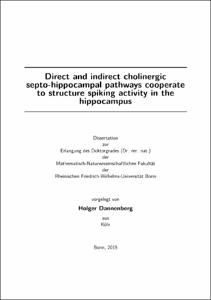Direct and indirect cholinergic septo-hippocampal pathways cooperate to structure spiking activity in the hippocampus

Direct and indirect cholinergic septo-hippocampal pathways cooperate to structure spiking activity in the hippocampus

| dc.contributor.advisor | Beck, Heinz | |
| dc.contributor.author | Dannenberg, Holger | |
| dc.date.accessioned | 2020-04-21T09:43:01Z | |
| dc.date.available | 2020-04-21T09:43:01Z | |
| dc.date.issued | 09.10.2015 | |
| dc.identifier.uri | https://hdl.handle.net/20.500.11811/6542 | |
| dc.description.abstract | The medial septum/vertical diagonal band of Broca complex (MSvDB) is a key structure that modulates hippocampal rhythmogenesis. Cholinergic neurons of the MSvDB play a central role in generating and pacing theta-band oscillations in the hippocampal formation during exploration, novelty detection, and memory encoding. However, how precisely cholinergic neurons affect hippocampal oscillatory activity and spiking rates of hippocampal neurons in vivo, has remained elusive. I therefore used silicon probe recordings of local field potentials and unit activity in the dorsal hippocampus in combination with cell type specific optogenetic activation of cholinergic MSvDB neurons to study the effects of synaptically released acetylcholine on hippocampal network activity in urethane-anesthetized mice.In vivo optogenetic activation of cholinergic MSvDB neurons induced hippocampal rhythmogenesis at the theta (3-6 Hz) and slow gamma (26-48 Hz) frequency range with a suppression of peri-theta frequencies. Interestingly, this effect was independent from the stimulation frequency. In addition, stimulation of cholinergic MSvDB neurons resulted in a net increase of interneuron firing with a concomitant net decrease of principal cell firing in the hippocampal CA3 subfield. I used focal injections of cholinergic blockers either into the MSvDB or the hippocampus to demonstrate that cholinergic MSvDB neurons modulate hippocampal network activity via two distinct pathways. Focal injection of a cholinergic blocker cocktail into the hippocampus strongly diminished the cholinergic stimulation-induced spiking rate modulation of hippocampal interneurons and principal cells. This demonstrates that modulation of neuronal activity in hippocampal subfield CA3 by cholinergic MSvDB neurons is mediated via direct septo-hippocampal projections. In contrast, focal injection of atropine, a blocker of the muscarinic type of acetylcholine receptors, into the MSvDB had no effect on spiking rate modulation in CA3, but abolished hippocampal theta synchronization. This strongly suggests that activity of an indirect septo-hippocampal pathway induces hippocampal theta oscillations via an intraseptal relay. Furthermore, cholinergic neurons depolarized parvalbumin-positive (PV+) GABAergic neurons within the MSvDB in vitro, and optogenetic activation of these fast spiking neurons in vivo induced hippocampal rhythmic activity precisely at the stimulation frequency. Taken together, these data suggest an intraseptal relay with a strong contribution of PV+ GABAergic MSvDB neurons in pacing hippocampal theta oscillations. Activation of both the direct and indirect pathways causes a reduction in CA3 pyramidal neuron firing and a more precise coupling to theta oscillatory phase with CA3 interneurons preferentially firing at the descending phase and CA3 principal neurons preferentially firing near the trough of the ongoing theta oscillation recorded at the pyramidal cell layer. The two identified anatomically and functionally distinct pathways are likely relevant for cholinergic control of encoding vs. retrieval modes in the hippocampus. | en |
| dc.language.iso | eng | |
| dc.rights | In Copyright | |
| dc.rights.uri | http://rightsstatements.org/vocab/InC/1.0/ | |
| dc.subject | Acetylcholin | |
| dc.subject | Encoding | |
| dc.subject | Hippocampus | |
| dc.subject | Mediales Septum | |
| dc.subject | Theta-Oszillation | |
| dc.subject | In-vivo-Elektrophysiologie | |
| dc.subject | Acetylcholine | |
| dc.subject | Medial septum | |
| dc.subject | theta oscillation | |
| dc.subject | in vivo electrophysiology | |
| dc.subject.ddc | 570 Biowissenschaften, Biologie | |
| dc.title | Direct and indirect cholinergic septo-hippocampal pathways cooperate to structure spiking activity in the hippocampus | |
| dc.type | Dissertation oder Habilitation | |
| dc.publisher.name | Universitäts- und Landesbibliothek Bonn | |
| dc.publisher.location | Bonn | |
| dc.rights.accessRights | openAccess | |
| dc.identifier.urn | https://nbn-resolving.org/urn:nbn:de:hbz:5n-41414 | |
| ulbbn.pubtype | Erstveröffentlichung | |
| ulbbnediss.affiliation.name | Rheinische Friedrich-Wilhelms-Universität Bonn | |
| ulbbnediss.affiliation.location | Bonn | |
| ulbbnediss.thesis.level | Dissertation | |
| ulbbnediss.dissID | 4141 | |
| ulbbnediss.date.accepted | 16.09.2015 | |
| ulbbnediss.institute | Medizinische Fakultät / Kliniken : Klinik für Epileptologie | |
| ulbbnediss.fakultaet | Mathematisch-Naturwissenschaftliche Fakultät | |
| dc.contributor.coReferee | Witke, Walter |
Files in this item
This item appears in the following Collection(s)
-
E-Dissertationen (4306)




